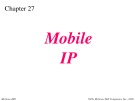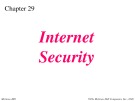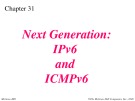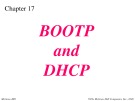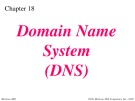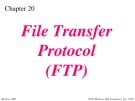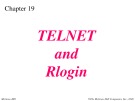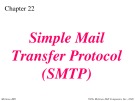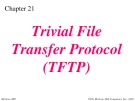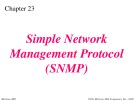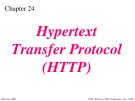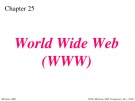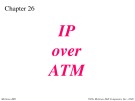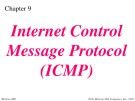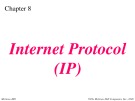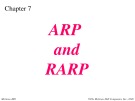
Protocol suites
-
Chapter 5: Transport Layer UDP and TCP. Overview of Transport Layer, UDP Protocol, UDP Protocol, types of data deliveries, port numbers, IP addresses versus port numbers, IANA ranges, socket, address, Multiplexing and demultiplexing, error control, position of UDP, TCP, and SCTP in TCP/IP suite.
 59p
59p  registergmxt
registergmxt
 27-05-2018
27-05-2018
 54
54
 2
2
 Download
Download
-
Mobile communication has received a lot of attention in the last decade. The interest in mobile communication on the Internet means that the IP protocol, originally designed for stationary devices, must be enhanced to allow the use of mobile computers, computers that move from one network to another.
 26p
26p  tangtuy09
tangtuy09
 26-04-2016
26-04-2016
 45
45
 3
3
 Download
Download
-
In this chapter, you will learn to: Differentiate between two categories of cryptography schemes; understand four aspects of security; understand the concept of digital signature; understand the role of key management in entity authentication; know how and where IPSec, TLS, and PPG provide security.
 41p
41p  tangtuy09
tangtuy09
 26-04-2016
26-04-2016
 56
56
 3
3
 Download
Download
-
Real-time Transport Protocol (RTP) is the protocol designed to handle real-time traffic on the Internet. RTP does not have a delivery mechanism (multicasting, port numbers, and so on); it must be used with UDP. RTP stands between UDP and the application program. The main contributions of RTP are timestamping, sequencing, and mixing facilities. This chapter provides knowledge of RTP and RTCP.
 29p
29p  tangtuy09
tangtuy09
 26-04-2016
26-04-2016
 54
54
 2
2
 Download
Download
-
Upon completion you will be able to: Understand the difference between an internet and an extranet, understand private, hybrid, and virtual private networks, understand how VPN can guarantee privacy, understand the mechanism of NAT.
 14p
14p  tangtuy09
tangtuy09
 26-04-2016
26-04-2016
 74
74
 7
7
 Download
Download
-
In this chapter you will learn: Understand the shortcomings of IPv4; know the IPv6 address format, address types, and abbreviations; be familiar with the IPv6 header format; know the extension header types; know the differences between ICMPv4 and ICMPv6; know the strategies for transitioning from IPv4 to IPv6.
 63p
63p  tangtuy09
tangtuy09
 26-04-2016
26-04-2016
 59
59
 3
3
 Download
Download
-
In this chapter we discuss our first client/server application program, Dynamic Host Configuration Protocol (DHCP). This application is discussed first because it is the first client/server application program that is used after a host is booted. In other words, it serves as a bootstrap when a host is booted and supposed to be connected to the Internet, but the host does not know its IP address.
 11p
11p  tangtuy09
tangtuy09
 26-04-2016
26-04-2016
 75
75
 2
2
 Download
Download
-
After studying this chapter you will be able to: Understand how the DNS is organized, know the domains in the DNS, know how a name or address is resolved, be familiar with the query and response formats, understand the need for DDNS.
 41p
41p  tangtuy09
tangtuy09
 26-04-2016
26-04-2016
 66
66
 4
4
 Download
Download
-
Upon completion you will be able to: Understand the connections needed for FTP file transfer be familiar with FTP commands and responses know the differences between FTP and TFTP be familiar with TFTP message types understand TFTP flow and error control.
 26p
26p  tangtuy09
tangtuy09
 26-04-2016
26-04-2016
 57
57
 3
3
 Download
Download
-
In this chapter you will learn: Concept, network virtual terminal (NVT), NVT character set, embedding, options, option negotiation, suboption negotiation, controlling the server, out-of-band signaling.
 41p
41p  tangtuy09
tangtuy09
 26-04-2016
26-04-2016
 49
49
 2
2
 Download
Download
-
The main contents of this chapter include all of the following: User agent (UA), addresses, delayed delivery, aliases, mail transfer agent (MTA), commands and responses, mail transfer phases, mime, mail delivery, mail access protocols.
 35p
35p  tangtuy09
tangtuy09
 26-04-2016
26-04-2016
 75
75
 4
4
 Download
Download
-
Transferring files from one computer to another is one of the most common tasks expected from a networking or internetworking environment. As a matter of fact, the greatest volume of data exchange in the Internet today is due to file transfer. In this chapter, we discuss two protocols involved in transferring files: File Transfer Protocol (FTP) and Trivial File Transfer Protocol (TFTP).
 23p
23p  tangtuy09
tangtuy09
 26-04-2016
26-04-2016
 58
58
 3
3
 Download
Download
-
The chapter has several objectives: To discuss SNMP as a framework for managing devices in an internet using the TCP/IP protocol suite; to define a manager as a host that runs SNMP client and any agents as a router or host that runs a server program; discuss SMI and MIB, which are used by SNMP; to show how SMI names objects, defines the type of data, and encodes data;...
 38p
38p  tangtuy09
tangtuy09
 26-04-2016
26-04-2016
 59
59
 3
3
 Download
Download
-
The Hypertext Transfer Protocol (HTTP) is a protocol used mainly to access data on the World Wide Web. HTTP functions like a combination of FTP and SMTP. This chapter provides knowledge of Hypertext Transfer Protocol (HTTP): HTTP transaction, request message, response message, header, examples, some other features.
 25p
25p  tangtuy09
tangtuy09
 26-04-2016
26-04-2016
 46
46
 2
2
 Download
Download
-
The chapter has several objectives: To discuss the architecture of WWW and describe the concepts of hypertext and hypermedia; to describe Web clients and Web servers and their components; to define URL as a tool to identify a Web server; to introduce three different Web documents: static document, dynamic document, and active document;...
 24p
24p  tangtuy09
tangtuy09
 26-04-2016
26-04-2016
 46
46
 3
3
 Download
Download
-
Upon completion you will be able to: Review the features of an ATM WAN, understand how an a datagram can pass through an ATM WAN, understand how an IP packet is encapsulated in cells, understand how cells are routed in an ATM network, understand the function of ATMARP.
 28p
28p  tangtuy09
tangtuy09
 26-04-2016
26-04-2016
 36
36
 2
2
 Download
Download
-
After studying this chapter you will be able to: Be familiar with the ICMP message format, know the types of error reporting messages, know the types of query messages, be able to calculate the ICMP checksum, know how to use the ping and traceroute commands, understand the modules and interactions of an ICMP package.
 51p
51p  tangtuy09
tangtuy09
 26-04-2016
26-04-2016
 52
52
 4
4
 Download
Download
-
In this chapter students will be able to: Understand the format and fields of a datagram, understand the need for fragmentation and the fields involved, understand the options available in an IP datagram, be able to perform a checksum calculation, understand the components and interactions of an IP package.
 61p
61p  tangtuy09
tangtuy09
 26-04-2016
26-04-2016
 50
50
 3
3
 Download
Download
-
Upon completion of this lesson, the successful participant will be able to: Understand the need for ARP, understand the cases in which ARP is used, understand the components and interactions in an ARP package, understand the need for RARP.
 34p
34p  tangtuy09
tangtuy09
 26-04-2016
26-04-2016
 49
49
 2
2
 Download
Download
-
Upon completion you will be able to: Know the purpose of IGMP, know the types of IGMP messages, understand how a member joins a group and leaves a group, understand membership monitoring, understand how an IGMP message is encapsulated, understand the interactions of the modules of an IGMP package.
 28p
28p  tangtuy09
tangtuy09
 26-04-2016
26-04-2016
 44
44
 3
3
 Download
Download
CHỦ ĐỀ BẠN MUỐN TÌM









